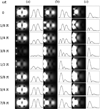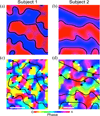Magnetic resonance imaging at ultrahigh fields
- PMID: 24686229
- PMCID: PMC4135536
- DOI: 10.1109/TBME.2014.2313619
Magnetic resonance imaging at ultrahigh fields
Abstract
Since the introduction of 4 T human systems in three academic laboratories circa 1990, rapid progress in imaging and spectroscopy studies in humans at 4 T and animal model systems at 9.4 T have led to the introduction of 7 T and higher magnetic fields for human investigation at about the turn of the century. Work conducted on these platforms has demonstrated the existence of significant advantages in SNR and biological information content at these ultrahigh fields, as well as the presence of numerous challenges. Primary difference from lower fields is the deviation from the near field regime; at the frequencies corresponding to hydrogen resonance conditions at ultrahigh fields, the RF is characterized by attenuated traveling waves in the human body, which leads to image nonuniformities for a given sample-coil configuration because of interferences. These nonuniformities were considered detrimental to the progress of imaging at high field strengths. However, they are advantageous for parallel imaging for signal reception and parallel transmission, two critical technologies that account, to a large extend, for the success of ultrahigh fields. With these technologies, and improvements in instrumentation and imaging methods, ultrahigh fields have provided unprecedented gains in imaging of brain function and anatomy, and started to make inroads into investigation of the human torso and extremities. As extensive as they are, these gains still constitute a prelude to what is to come given the increasingly larger effort committed to ultrahigh field research and development of ever better instrumentation and techniques.
Figures











References
-
- van der Kolk AG, Hendrikse J, Luijten PR. Ultrahigh-field magnetic resonance imaging: The clinical potential for anatomy, pathogenesis, diagnosis, and treatment planning in brain disease. Neuroimaging Clin. N Amer. 2012 May;22(2):343–362. - PubMed
-
- Umutlu L, Ladd ME, Forsting M, Lauenstein T. 7 Tesla MR imaging: Opportunities and challenges. Rofo. 2014 Feb;186(2):121–129. - PubMed
-
- Niendorf T, Graessl A, Thalhammer C, Dieringer MA, Kraus O, Santoro D, Fuchs K, Hezel F, Waiczies S, Ittermann B, Winter L. Progress and promises of human cardiac magnetic resonance at ultra-high fields: a physics perspective. J. Magn. Reson. 2013 Apr;229:208–222. - PubMed
-
- Moser E, Stahlberg F, Ladd ME, Trattnig S. 7-T MR-from research to clinical applications? NMR Biomed. 2012 May;25(5):695–716. - PubMed
Publication types
MeSH terms
Grants and funding
LinkOut - more resources
Full Text Sources
Other Literature Sources
Medical
Research Materials

